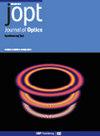双汉勒共振与光偏振角和横向磁场方向的关系
IF 2.7
4区 物理与天体物理
Q3 OPTICS
引用次数: 0
摘要
我们介绍了双韩勒共振谱对光偏振角和横向磁场(TMF)方向依赖性的实验和理论研究。实验是利用含有缓冲气体的铷蒸气电池对 87Rb D1 线的转变进行的。实验结果表明,沿横向磁场方向的微小光偏振分量会在双汉乐共振信号中引入不对称现象。信号中不对称的大小和符号对 TMF 方向都很敏感,这表明有可能采用一种方法来现场测量线圈产生的磁场方向。考虑到 TMF 存在时基态泽曼子水平之间的种群重新分布,可以解释这种不对称的物理根源。此外,我们还系统地改变了极化角和 TMF 方向,以研究它们对汉勒共振线剖面的影响。我们证明,无论 TMF 方向如何,只要旋转光偏振矢量,双汉乐共振就会变为暗汉乐共振。我们建立了一个基于退化两级系统的简单理论模型来解释我们的实验观察结果。本文章由计算机程序翻译,如有差异,请以英文原文为准。
Double Hanle resonance dependence on light polarization angle and transverse magnetic field direction
We present experimental and theoretical investigations of the dependence of double Hanle resonance spectrum on the light polarization angle and the direction of the applied transverse magnetic field (TMF). The experiments are done for transition of 87Rb D1 line using a rubidium vapor cell containing buffer gas. We show that a small light polarization component along the direction of TMF introduces asymmetry in the double Hanle resonance signal. Both the magnitude and sign of asymmetry in the signal are sensitive to the TMF orientation, suggesting a possible method for in-situ measurement of the direction of the magnetic fields generated by the coils. The physical origin of this asymmetry is explained by considering the redistribution of population among the ground-state Zeeman sublevels in the presence of TMF. In addition, we systematically vary both the polarization angle and TMF direction to study their effect on the line profile of Hanle resonances. We demonstrate that a double Hanle resonance changes to a dark Hanle resonance by rotating the light polarization vector irrespective of the TMF direction. We have developed a simple theoretical model based on a degenerate two-level system to explain our experimental observations.
求助全文
通过发布文献求助,成功后即可免费获取论文全文。
去求助
来源期刊

Journal of Optics
OPTICS-
CiteScore
4.50
自引率
4.80%
发文量
237
审稿时长
1.9 months
期刊介绍:
Journal of Optics publishes new experimental and theoretical research across all areas of pure and applied optics, both modern and classical. Research areas are categorised as:
Nanophotonics and plasmonics
Metamaterials and structured photonic materials
Quantum photonics
Biophotonics
Light-matter interactions
Nonlinear and ultrafast optics
Propagation, diffraction and scattering
Optical communication
Integrated optics
Photovoltaics and energy harvesting
We discourage incremental advances, purely numerical simulations without any validation, or research without a strong optics advance, e.g. computer algorithms applied to optical and imaging processes, equipment designs or material fabrication.
 求助内容:
求助内容: 应助结果提醒方式:
应助结果提醒方式:


